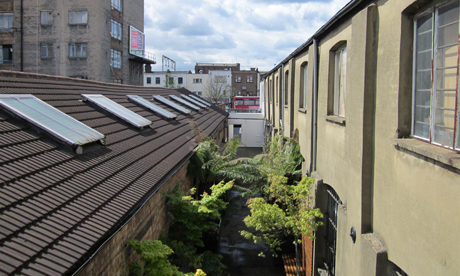Going nowhere – the East End art scene

View from Cell Project Space. Photograph: Francesca Brooks
As I write this on a perfect summer’s evening, the inaugural Fitzrovia Lates and new Thursday night gallery hop is taking place in that other part of the city. Just as crafty TV programmers wouldn’t schedule the finals of Strictly Come Dancing and X Factor to clash, East London’s First Thursdays and Fitzrovia’s Last Thursdays are not going head to head, but that isn’t to say they aren’t in competition.
Dazed & Confused began the scaremongering about our treasured local art scene with its provocative cover in May. ‘Is East London Dead?’ questioned a black figure dressed up like the Grim Reaper of the art world, a dodgy Damien Hirst rip-off.
A few weeks ago the Guardian joined in and printed an article claiming that “East End galleries” are being “forced to go West” as the “local scene ‘dies’”. The story suggested that as galleries like Nettie Horn and FRED Ltd continue to move away from Vyner Street and into Fitzrovia, the hub of the London art scene is also shifting.
Yet this account mistakes Vyner Street for the breadth of the East London art scene and views sales as the life force behind all creativity.
Fitzrovia is certainly the money maker, the new commercial and industrial hub of the art world. The idle art collector might favour the kind of constellatory art map that enables large sums of money to be spread over a small surface area at a time-saving pace, but what the East End has to offer stretches beyond Vyner Street and justifies a little wandering.
The focus of many East End spaces such as Space on Mare Street, Banner Repeater in Hackney Downs Station and Cell Project on Cambridge Heath Road is on exploration, education and experimentation. With talks and events, libraries and reading rooms, and warrens of artist studios hidden away behind the public walls of the galleries, institutions aren’t just showrooms for established artists. They are driven by a desire to shape a continually developing critical dialogue.
“For us the ‘scene’ is being in touch with the studio practice of our artists. This is still in East London,” writes Cell Project Space’s Director, Milika Muritu. Whilst rents for galleries in Fitzrovia might be smaller than the inflated prices of Vyner Street, it’s unlikely that penniless artists will be renting studio space in the rich lands behind Oxford Street.
There is much more freedom to be experimental in East London with project spaces and artist-led galleries supporting emerging practice and challenging ideas. Muritu admits that income and sales are essential to the running of the gallery, she claims that Cell is making the shift to “assist artists’ projects in becoming a reality. Not always in creating a finite statement, but to establish the gallery as an exploratory space to develop knowledge that can be used in the future.”
Not every gallery will take a risk on the infinite, but this is often where the most exciting ideas emerge and is an investment in the future of contemporary practice.
Transition Gallery on Andrews Road publishes its own zine called Arty, as well as the magazine Garageland. These are alternatives to the familiar glossies and inclusive of a lot of ‘irreverent’ artist-led content.
Transition Gallery director Cathy Lomax remembers publishing the first edition of Arty: “It felt very empowering. It was the most basic folded photocopy format but this meant I had complete control over it which was very important.”
Unlike the East End, Fitzrovia has a name which already sounds like an exclusive destination. Its network of slick white spaces conform to our conventional notion of an art gallery. Yet exclusivity is inevitably a way of alienating people.
Dalston Lane’s Fishbar Gallery deliberately avoided the white cube makeover, keeping the original wood cladding and shop front which recall the former life of the premises.
Director Olivia Arthur says that they “were also drawn to the idea of having a shopfront. A lot of people have been using warehouse spaces and making galleries in them which can be great, but there is something special about having a shopfront, being in a little high street, it makes you more local, less exclusive.”
I always pop into the Banner Repeater on Platform 1 of the Hackney Downs Station when I am early or late for a train. The exhibitions attract all kinds of curious platform-dwellers and the reading room is a gentle invitation for anyone to drift in. The Banner Repeater is my local and I’m even currently sporting a ‘BR’ canvas bag to prove it.
The sense of locality is proof that these East End galleries are deeply engaged with the area, the people, and the artists and studios which surround them. If the alternative is the art tourists of Fitzrovia, then this ‘scene’ still feels like a much more significant and exciting thing to be a part of.
